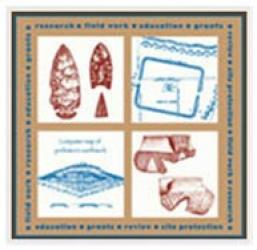
Indiana Archaeology Month - September will be the 26th annual statewide celebration of archaeology in our state, and we hope you will be able to attend some of the events which will be taking place. Again this year the commemorative poster will be available on our webpage, but we will not be producing printed posters.

The 2021 poster design focuses on archaeology and the production of Hoosier spirits. Studying patterns of the production, distribution, and consumption of Indiana goods is one area of historical archaeological research that can inform us about the lives of past Hoosiers. Highlighted are the following images:
- Beer wagon (upper left) - This 1942 photograph shows a loaded wagon of the Indianapolis Brewing Company, Inc., and painted on the wagon is encouragement for the public to buy war bonds and stamps. In the background is the War Memorial Plaza and Indianapolis Marion County Public Library. Image courtesy of the Bass Photo Co. Collection, Indiana Historical Society.
- Still (upper middle) - Game Warden Oliver Neal (right) and his son Fred Neal are shown in 1926 at a still discovered in Brown County. According to an obituary for him, Oliver Neal was born in Brown County in 1875 and served as State Park [Brown County] Superintendent and Game Warden when the park opened. Photographer Frank M. Hohenberger took the image, and his journal described the discovery of the still, an arrest, and court case which resulted. Hohenberger, also a newspaperman, spent 47 years recording the life, customs, and scenes of the hills of Brown County. From the Frank M. Hohenberger Photograph Collection, courtesy of The Lilly Library, Indiana University, Bloomington, Indiana.
- Historical postcard (upper right) - Shown is the Thieme & Wagner Brewery in Lafayette. The brewery was founded in 1863 by Frederick August Thieme and John Wagner, both of whom were immigrants from Germany. Information from the Tippecanoe County Historical Association states that this was considered to be a state-of-the-art brewing factory in the 1800s and early 1900s. Image courtesy of Indiana Album, Shirley and Mike Benham Collection.
Artifacts (not to scale) shown left to right:
- This whole glass bottle from Rich Lieber & Co., Indianapolis, was found during archaeological investigations at site 12Ma979 in downtown Indianapolis. This business appeared in the city directories from 1899-1905 and was described as manufacturers of mineral water and importers of wines, champagnes and whiskies. The bottle probably contained mineral water, which could be mixed in alcoholic drinks. Image courtesy of Tammy Seiter and Leeanne Mahoney, AECOM.
- This glass bottle is from the Indianapolis Brewing Company. The company began in the late 1880s with the merger of three breweries in the city, and it closed in 1948. Image courtesy of the Indiana Historical Society. Also from the Indianapolis Brewing Company is the great beer pitcher, ca. 1900-1918. The brewery closed in 1918 because of Prohibition but reopened in 1933. The pitcher is in the collection of the Indiana State Museum and Historic Sites.
- This glass bottle was discovered during archaeological investigations at 12Mo1083 in Indiana’s Morgan-Monroe State Forest. It was manufactured in 1935 and used for “Old Quaker” brand rye whiskey. Old Quaker was manufactured at a distillery in Lawrenceburg. The artifact was found during a Ball State University project funded in part by a grant from the National Park Service’s Historic Preservation Fund Program, which is administered in Indiana by the DNR-DHPA. Photograph by Rachel Wonders, Applied Anthropology Laboratories, Ball State University.
- The stoneware whiskey jug was found in Evansville during archaeological investigations by Cultural Resource Analysts, Inc. at site 12Vg1357. August Krogman established his distillery in Tell City, as stated on the jug itself, in 1863, and the business closed by the advent of Prohibition. Image courtesy of Cultural Resource Analysts, Inc.
The DHPA thanks those who gave permission for the use of their images in the design; those who are organizing and hosting Archaeology Month events; those who will attend the events; and our poster designer, Adam Cox of the DNR Division of Communications.
Summer Intern - Intern Maddy has been hard at work helping DHPA and Division of Forestry staff with a wide range of projects. So far, she has assisted with two different accidental discoveries and helped with a Phase II investigation at Ravinia State Forest. When in the office, she has been learning about the Section 106 process and developing GIS layers to assist the DHPA archaeology staff with project reviews. She has even branched out from archaeology and attended a Historic Preservation Fund grant closeout in Newburgh with our grants staff!

Archaeology Site of the Month - In honor of the 25th anniversary of a statewide celebration of archaeology in our state, we have been highlighting the 25th recorded archaeological site for each county in Indiana. This focus has spanned all 92 counties. Archaeological sites are each given a unique, sequential identification number as they are recorded. This helps archaeologists keep track of the artifacts that come from the site and differentiates it from other sites in the area. The numbering system tells archaeologists what state and county a site comes from, and what the specific number in that county belongs to the site. For example, Angel Mounds is archaeological site 12-Vg-1, meaning it is from Vanderburgh County (Vg), Indiana (12), and is the first documented site in that county (1). In this, our final installment of the 25th site series, we are highlighting the 25th site from Wabash through Whitley County.
Wabash County, 12-Wb-25: This site, consisting of flakes and a projectile point fragment, was documented by Ball State University along the banks of the Mississinewa River.
Warren County, 12-Wa-25: This Warren County site was documented by archaeologists with the Glenn A. Black Laboratory of Archaeology (Indiana University) as part of the Jordan Creek Watershed Project in 1975. The site consisted of a lithic knife, bifaces, and a small quantity of chert debris. Interestingly, the site form also notes that there were some historical artifacts on the site, but that they were not collected. This is an example of the changing attitudes in archaeology regarding historical artifacts. We now make an effort to record both precontact and historical artifacts as evidence of past human behavior.
Warrick County, 12-W-25: Glenn A. Black (the man who the Glenn A. Black Laboratory of Archaeology is named for) documented this site in 1950. His site form describes the site as being a village and lists artifacts including flint chips, projectile points, a partial drill, and grog tempered, plain, pottery.
Washington County, 12-Ws-25: This Late Archaic site was documented in 1975. Artifacts from the site included one end scraper, two Late Archaic points, one side scraper, one utilized flake, a biface fragment, an anvil, and a “fair quantity” of chert debris.
Wayne County, 12-Wy-25: Although this site is designated on the site form as a village, the only artifacts noted are “2 points.” Clearly, more information needs to be collected for this site!
Wells County, 12-We-25: This Middle Archaic site was documented in 1979. A moderate number of artifacts, including one Middle Archaic point (or possible drill), eight scrapers, one flake knife, one utilized flake, 21 chert flakes and three chert chunks were recorded.
White County, 12-Wh-25: Purdue University documented this Unidentified Precontact site in 1989. Artifacts noted included finishing, or retouch, flakes and fire cracked rock (FCR).
Whitley County, 12-Wi-25: Sometimes, even though a site number has been issued for a site, a site form is never completed for it. Currently, the DHPA has no information on 12-Wi-25 in our files!
Hopefully, over the course of this series, you have learned that there is a wide variety in the types of sites, and their importance, which are documented in Indiana’s 92 counties. We have seen the 25th site from the counties have included isolated finds and precontact mounds, lithic scatters and historic farmsteads. Some sites were documented decades ago, and some just a few years ago. All are important in teaching Hoosiers about our past.
This information is distributed via email by the Indiana Department of Natural Resources, Division of Historic Preservation and Archaeology (DHPA). This is meant to provide information on current archaeological topics and issues in which the DHPA is involved. An archive of past Archaeology News issues is available. If you have any questions, do not hesitate to contact our office at 317-232-1646.

Mission Statement: The Division of Historic Preservation and Archaeology promotes the conservation of Indiana’s cultural resources through public education efforts, financial incentives including several grant and tax credit programs, and the administration of state and federally mandated legislation.
Division of Historic Preservation and Archaeology, 402 W. Washington St., Room W274, Indianapolis, IN 46204. www.IN.gov/dnr/historic, www.facebook.com/INdhpa
Indiana Archaeology Month (September) webpage - http://www.in.gov/dnr/historic/3674.htm
